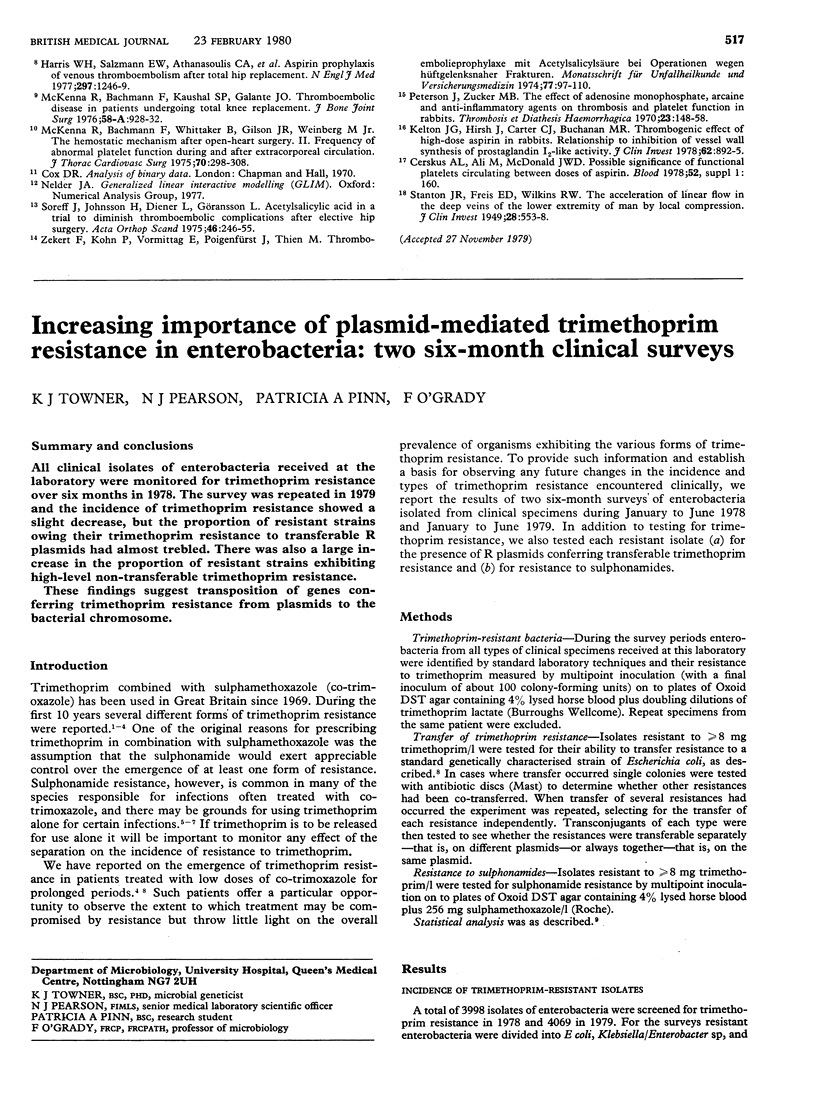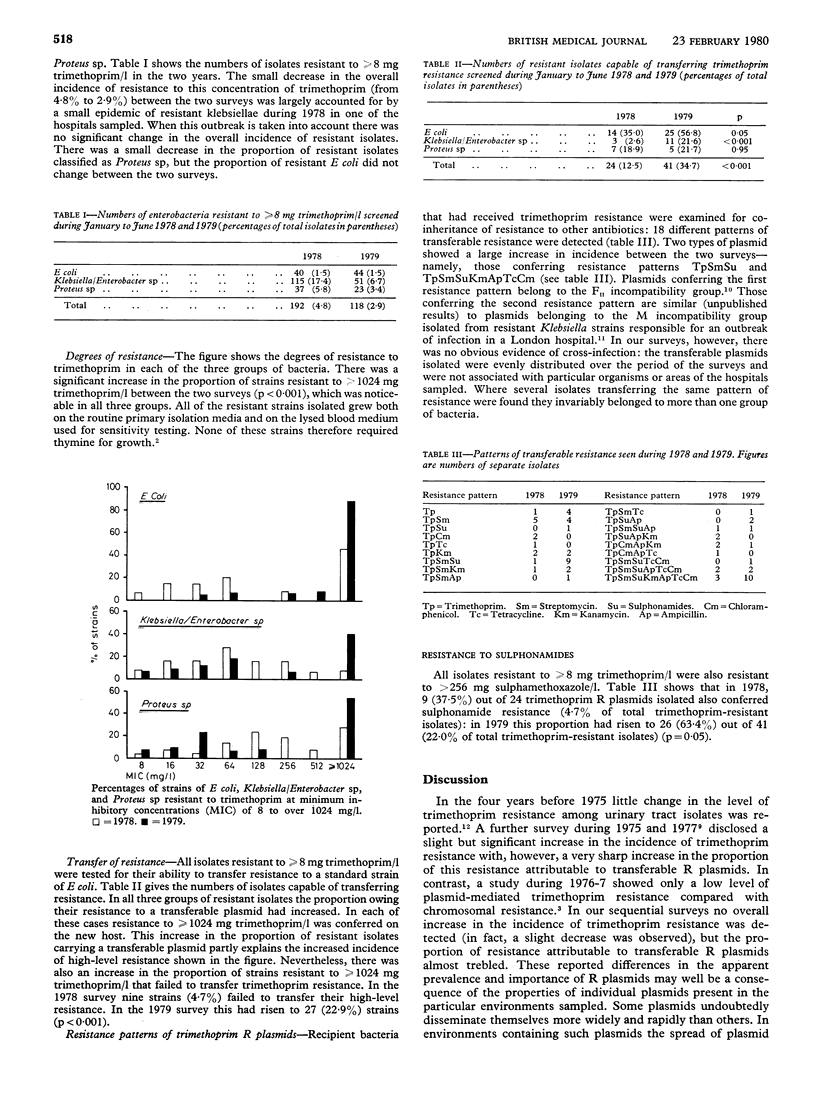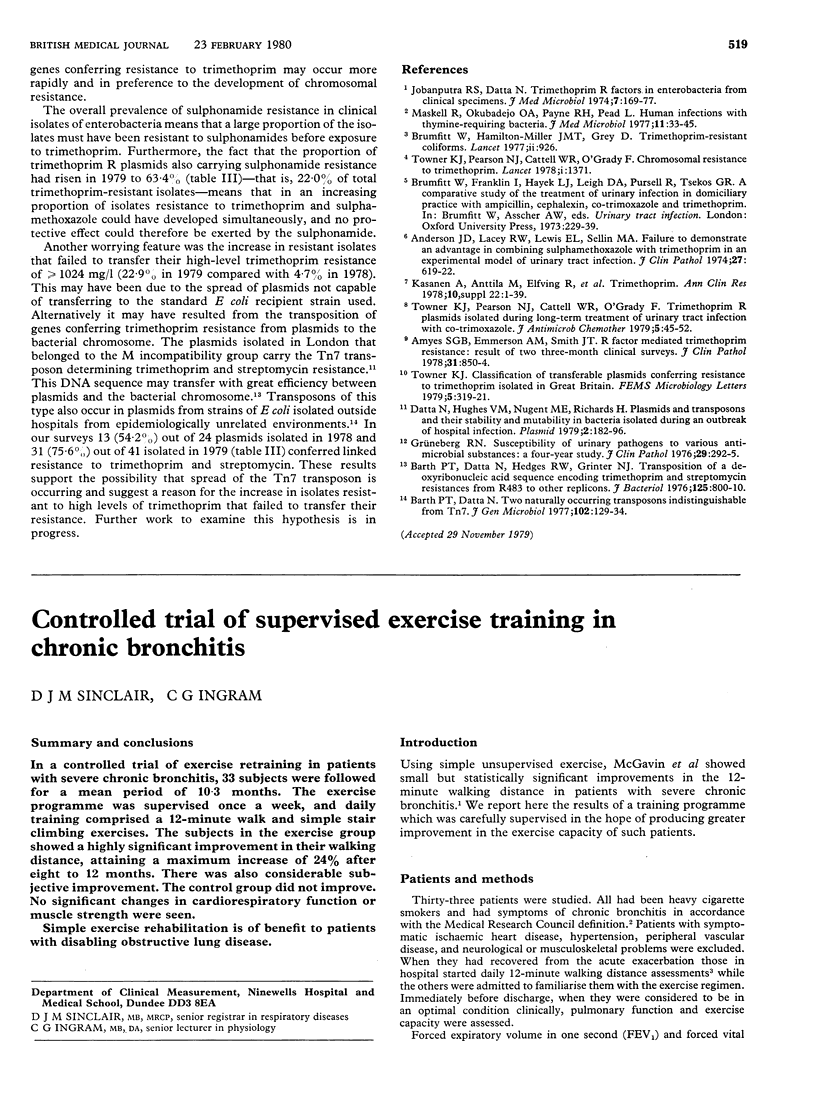Abstract
All clinical isolates of enterobacteria received at the laboratory were monitored for trimethoprim resistance over six months in 1978. The survey was repeated in 1979 and the incidence of trimethoprim resistance showed a slight decrease, but the proportion of resistant strains owing their trimethoprim resistance to transferable R plasmids had almost trebled. There was also a large increase in the proportion of resistant strains exhibiting high-level non-transferable trimethoprim resistance. These findings suggest transposition of genes conferring trimethoprim resistance from plasmids to the bacterial chromosome.
Full text
PDF


Selected References
These references are in PubMed. This may not be the complete list of references from this article.
- Amyes S. G., Emmerson A. M., Smith J. T. R-factor mediated trimethoprim resistance: result of two three-month clinical surveys. J Clin Pathol. 1978 Sep;31(9):850–854. doi: 10.1136/jcp.31.9.850. [DOI] [PMC free article] [PubMed] [Google Scholar]
- Anderson J. D., Lacey R. W., Lewis E. L., Sellin M. A. Failure to demonstrate an advantage in combining sulphamethoxazole with trimethoprim in an experimental model of urinary infection. J Clin Pathol. 1974 Aug;27(8):619–622. doi: 10.1136/jcp.27.8.619. [DOI] [PMC free article] [PubMed] [Google Scholar]
- Barth P. T., Datta N., Hedges R. W., Grinter N. J. Transposition of a deoxyribonucleic acid sequence encoding trimethoprim and streptomycin resistances from R483 to other replicons. J Bacteriol. 1976 Mar;125(3):800–810. doi: 10.1128/jb.125.3.800-810.1976. [DOI] [PMC free article] [PubMed] [Google Scholar]
- Barth P. T., Datta N. Two naturally occurring transposons indistinguishable from Tn7. J Gen Microbiol. 1977 Sep;102(1):129–134. doi: 10.1099/00221287-102-1-129. [DOI] [PubMed] [Google Scholar]
- Datta N., Hughes V. M., Nugent M. E., Richards H. Plasmids and transposons and their stability and mutability in bacteria isolated during an outbreak of hospital infection. Plasmid. 1979 Apr;2(2):182–196. doi: 10.1016/0147-619x(79)90037-4. [DOI] [PubMed] [Google Scholar]
- Grüneberg R. N. Susceptibility of urinary pathogens to various antimicrobial substances: a four-year study. J Clin Pathol. 1976 Apr;29(4):292–295. doi: 10.1136/jcp.29.4.292. [DOI] [PMC free article] [PubMed] [Google Scholar]
- Jobanputra R. S., Datta N. Trimethoprim R factors in enterobacteria from clinical specimens. J Med Microbiol. 1974 May;7(2):169–177. doi: 10.1099/00222615-7-2-169. [DOI] [PubMed] [Google Scholar]
- Kasanen A., Anttila M., Elfving R., Kahela P., Saarimaa H., Sundquist H., Tikkanen R., Toivanen P. Trimethoprim. Pharmacology, antimicrobial activity and clinical use in urinary tract infections. Ann Clin Res. 1978;10 (Suppl 22):1–39. [PubMed] [Google Scholar]
- Maskell R., Okubadejo O. A., Payne R. H., Pead L. Human infections with thymine-requiring bacteria. J Med Microbiol. 1978 Feb;11(1):33–45. doi: 10.1099/00222615-11-1-33. [DOI] [PubMed] [Google Scholar]
- Towner K. J., Pearson N. J., Cattell W. R., O'Grady F. Chromosomal resistance to trimethoprim. Lancet. 1978 Jun 24;1(8078):1371–1371. doi: 10.1016/s0140-6736(78)92456-x. [DOI] [PubMed] [Google Scholar]
- Towner K. J., Pearson N. J., Cattell W. R., O'Grady F. Trimethoprim R plasmids isolated during long-term treatment of urinary tract infection with co-trimoxazole. J Antimicrob Chemother. 1979 Jan;5(1):45–52. doi: 10.1093/jac/5.1.45. [DOI] [PubMed] [Google Scholar]
- Trimethoprim--resistant coliforms. Lancet. 1977 Oct 29;2(8044):926–926. [PubMed] [Google Scholar]


